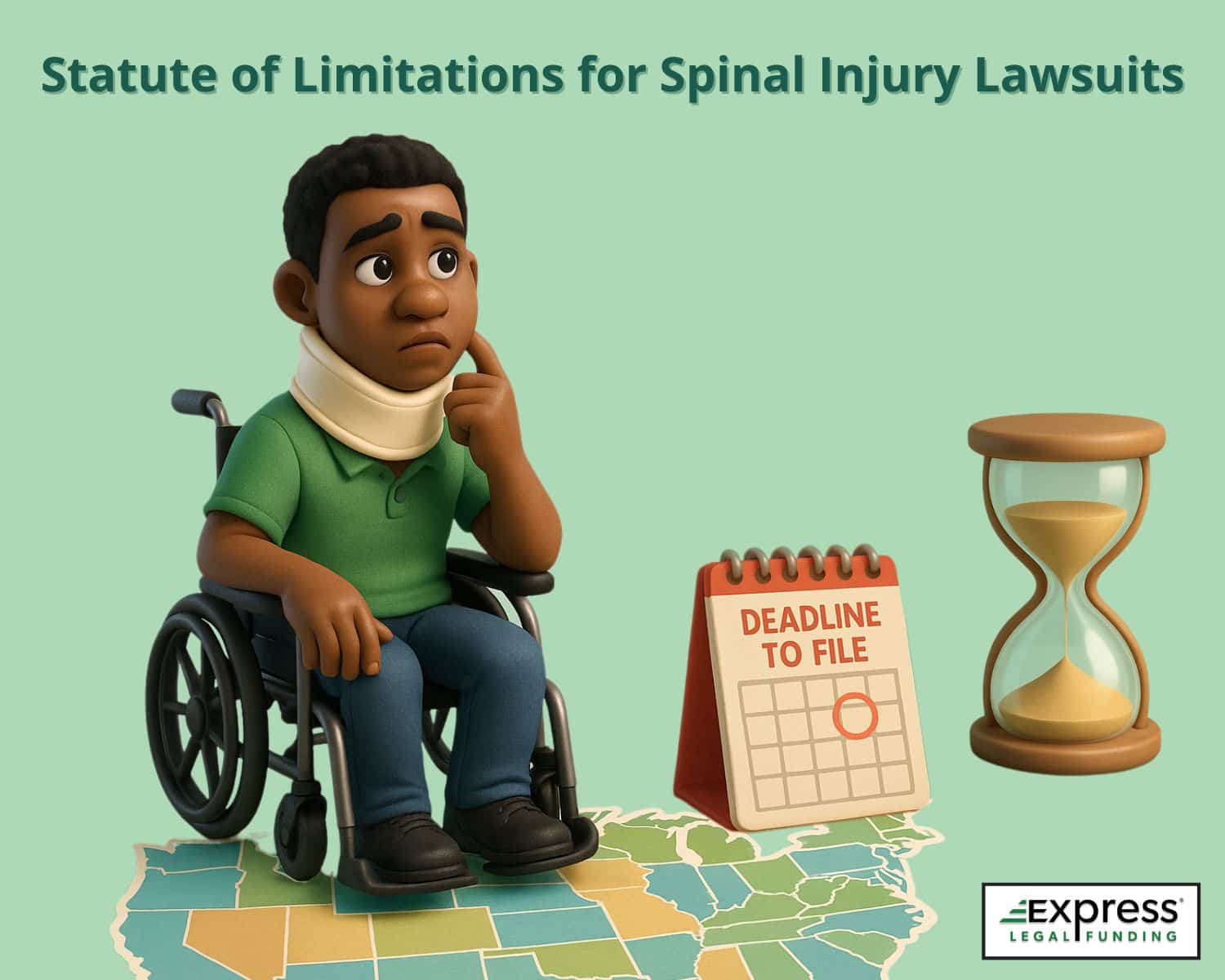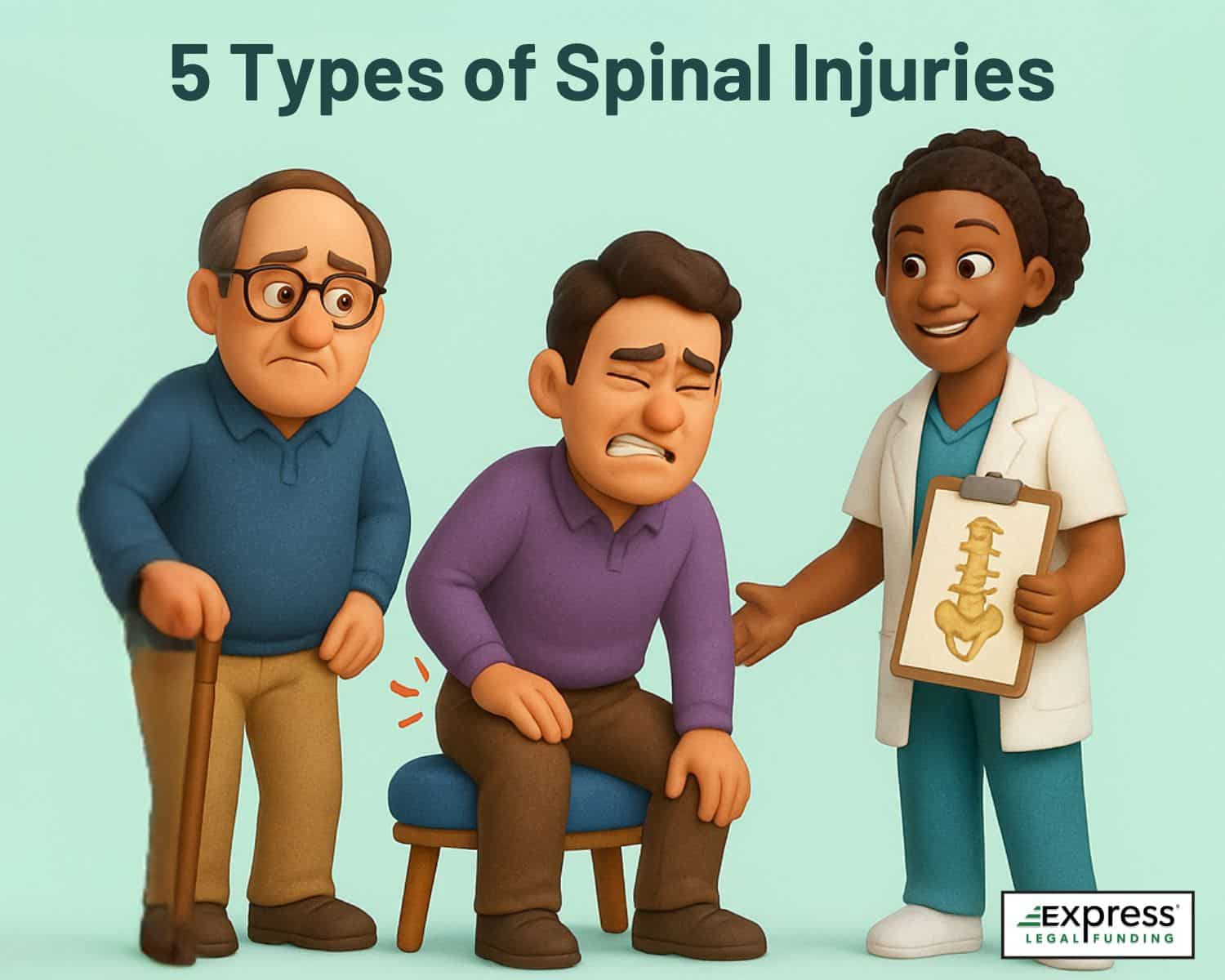
Spinal injuries are among the most serious and life-altering conditions a person can suffer, often resulting in permanent disability, chronic pain, and a significant loss of independence.
Whether caused by a car accident, fall, workplace incident, or other traumatic event, damage to the spinal cord or surrounding vertebrae can lead to long-term medical complications and overwhelming financial stress.
When a spinal injury is caused by someone else’s negligence, the injured person may be entitled to pursue compensation through a personal injury lawsuit. However, not all spinal injuries are treated equally in the eyes of the law.
The type, location, and severity of the spinal injury play a central role in determining how much a claim is worth. Some injuries may result in temporary discomfort, while others cause irreversible paralysis and lifelong care needs.
Understanding how specific types of spinal injuries affect both medical outcomes and legal valuations is essential for anyone navigating the recovery process or filing a personal injury claim.
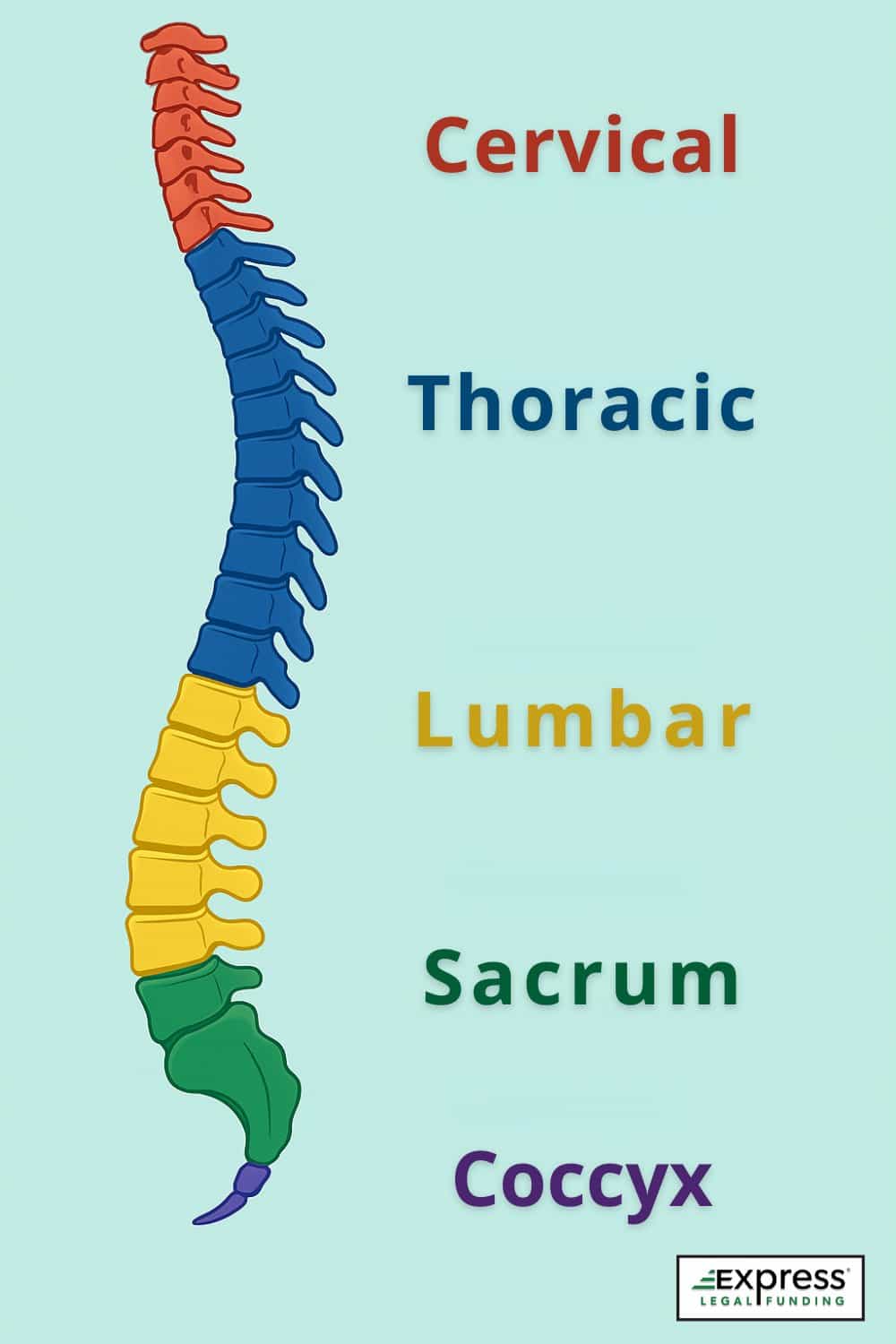
In this article, we’ll explore:
- The five primary types of spinal injuries
- How each type impacts a patient’s quality of life
- The legal implications for personal injury claims and settlements
- How injury severity affects eligibility for pre-settlement funding
What Is a Spinal Cord Injury?
A spinal cord injury (SCI) is damage to the spinal cord or the nerves at the base of the spinal canal. This damage can disrupt the brain’s ability to send signals to the body, often resulting in permanent changes in movement, sensation, or strength below the injury site.
Spinal cord injuries can range from minor and manageable to severe and permanent. In legal and medical settings, spinal injuries are defined by their impact on physical function and quality of life, making them a key factor in personal injury claims and settlements.
Medical Classification of Spinal Cord Injuries
From a medical perspective, spinal cord injuries are classified based on the region of the spine affected and the degree of functional loss, ranging from incomplete injuries, where some motor or sensory function remains, to complete injuries, which result in total loss of function below the injury site.
According to doctors at the Mayo Clinic, people who have had a spinal cord injury may also experience mental, emotional, and social side effects.
Legal Classification of Spinal Cord Injuries in Personal Injury Cases
In personal injury claims involving spinal injuries, legal classifications are key to determining settlement value. These classifications guide how courts and insurers assess damages, including medical treatment costs, lost wages, and emotional distress.
The close connection between a medical diagnosis and its legal implications means attorneys must take a comprehensive approach to valuation. Proper legal framing ensures compensation accurately reflects the injury’s severity, permanency, and impact on quality of life.
Learn more about the value of spinal injuries in our guide: How Much Is a Spinal Cord Injury Lawsuit Settlement Worth?
5 Types of Spinal Injuries
The legal and medical definitions serve as a foundation for understanding how different types of spinal injuries can uniquely impact lawsuit settlements, emphasizing the need for precise and informed evaluations in these cases.
1. Cervical Spine Injuries (Neck Region)
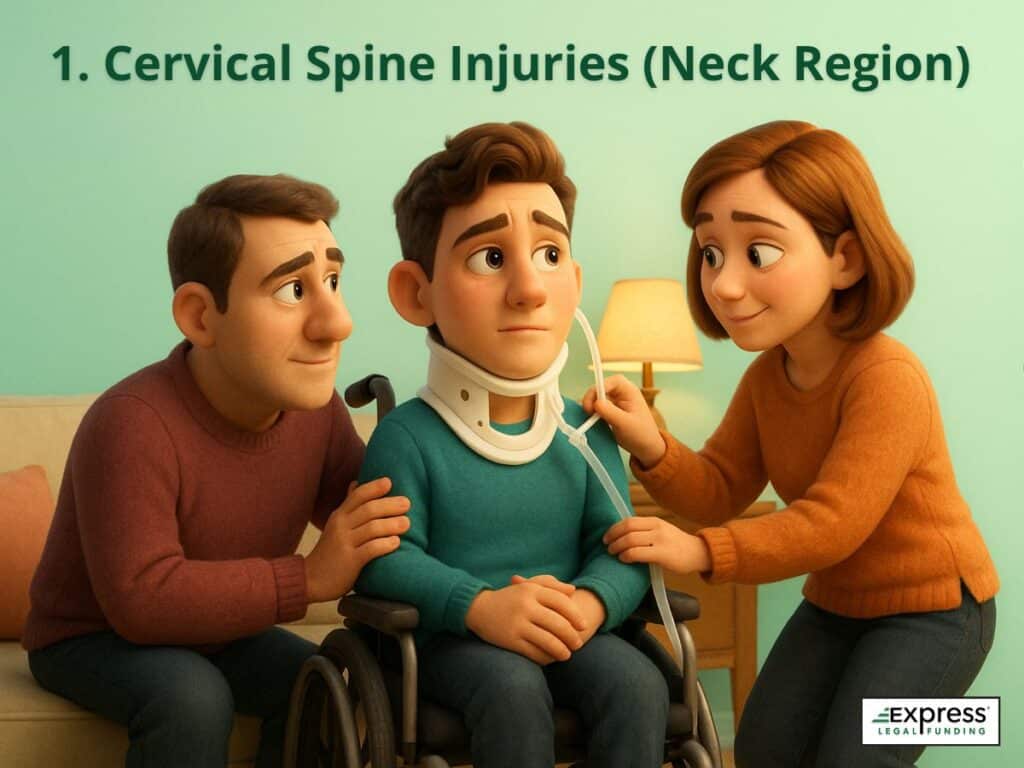
Cervical spine injuries affect the uppermost section of the spine, involving the seven vertebrae labeled C1 through C7. These vertebrae support the neck, protect the spinal cord, and allow head and neck mobility. Due to their close proximity to the brainstem and central nervous system, injuries in this region often carry serious and potentially life-altering consequences.
- Common Causes: High-impact trauma such as car accidents, slips and falls, diving injuries, and contact sports. These injuries frequently present as fractures, dislocations, herniated discs, or severe grades of whiplash.
- Symptoms: Vary by severity and location, ranging from neck stiffness and localized pain to nerve damage, partial paralysis (paresis), or full quadriplegia (complete paralysis from the neck down).
Because cervical injuries can drastically limit mobility and independence, they often result in:
- Loss of employment or earning capacity
- Emotional distress and social isolation
- Increased dependence on family members or long-term caregivers
These far-reaching effects make cervical spine injuries one of the most devastating and highest-value claims in personal injury law, particularly when they result in permanent disability or require lifelong medical support.
Impact on the Patient’s Life
Cervical spine injuries often have life-altering consequences, particularly when the damage results in partial or total paralysis. These injuries can severely restrict a person’s ability to perform basic daily activities, such as dressing, bathing, or feeding themselves. Many patients lose the ability to drive, work, or engage in recreational and social activities, leading to a substantial decline in independence and quality of life.
Depending on the severity and spinal level affected (especially C1–C4), individuals may require:
- Ongoing medical care
- Respiratory support or ventilators
- Home modifications and assistive devices
- Full-time caregivers or assisted living arrangements
In addition to the physical burden, patients often experience emotional and psychological challenges, including depression, anxiety, and social isolation, as they adjust to their new limitations and dependence on others.
How It Affects the Claim or Lawsuit
Cervical spine injuries frequently lead to high-value personal injury claims due to the extensive medical treatment, long-term care needs, and loss of earning capacity involved. The long-term or permanent nature of these injuries makes them easier to quantify in terms of damages, which can strengthen the injured party’s legal position.
From a legal standpoint:
- Higher Settlement Potential: Cervical injuries are often well-documented with diagnostic tools like MRI and CT scans, making it easier to present objective medical evidence that supports a substantial claim. Additionally, treatments like cervical fusion surgery are invasive and costly, which can significantly increase the potential settlement value.
- Clear Causation in Common Scenarios: Car accidents and serious falls frequently result in cervical trauma. In many of these cases, liability is easier to establish, particularly when negligent behavior (e.g., rear-end collision, unsafe premises) is involved.
- Economic and Non-Economic Damages: Courts recognize both the tangible losses (lost wages, medical expenses) and intangible harms (pain and suffering, loss of enjoyment of life) associated with cervical spine injuries.
Legal Doctrines at Play:
- Comparative Fault: If the injured party contributed to the incident (e.g., not wearing a seatbelt or driving while wearing headphones), their compensation may be reduced in proportion to their degree of fault.
- Catastrophic Injury Classification: Many jurisdictions recognize cervical spine injuries, particularly those that result in permanent impairment or paralysis, as catastrophic injuries under the law.
- Future Damages and Life Care Planning: Courts may rely on expert testimony to project lifetime care costs, vocational loss, and the need for ongoing therapies or home assistance.
2. Thoracic Spine Injuries (Upper Back)
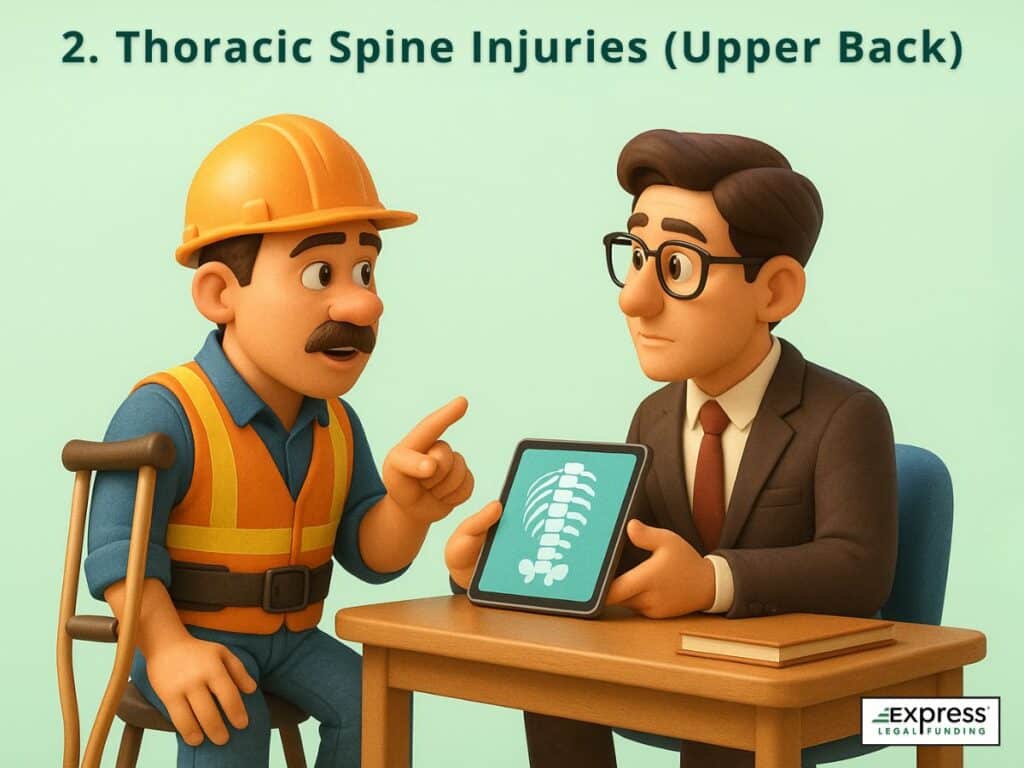
Thoracic spine injuries occur in the upper back region, involving the twelve vertebrae known as Thoracic spine injuries occur in the mid-to-upper back region, involving the twelve vertebrae labeled T1 through T12. These vertebrae connect to the rib cage, making the thoracic spine more rigid and structurally stable than the cervical or lumbar regions.
Although less commonly injured, trauma to this area can still result in serious and life-altering complications, especially when the spinal cord is affected.
- Common Causes: High-impact accidents such as motor vehicle collisions, falls from significant heights, sports-related trauma, or blunt force injuries.
- Symptoms: May include mid-back pain, muscle weakness, reduced mobility, and in more severe cases, partial or complete paralysis below the injury site due to spinal cord involvement.
Impact on the Patient’s Life
While the thoracic spine is relatively protected, injuries to this region can significantly limit a person’s core strength, balance, and ability to perform physical tasks. Patients often experience:
- Chronic pain
- Restricted range of motion
- Difficulty with walking, lifting, or sitting for extended periods
In more severe cases, injury to the thoracic spinal cord can cause paraplegia, requiring wheelchair use, adaptive equipment, and long-term rehabilitation. The resulting limitations can disrupt a patient’s career, independence, and emotional well-being, particularly when pain and disability persist despite treatment.
How It Affects the Claim or Lawsuit
Thoracic spine injuries are legally significant due to their lasting physical impact and potential to impair a person’s earning capacity and lifestyle. These cases often involve detailed medical evaluations and functional assessments to establish the extent of harm and future care needs.
From a Legal Standpoint:
- Higher Settlement Potential: Thoracic injuries can lead to substantial compensation, especially when imaging and specialist reports confirm damage to vertebrae or spinal cord structures.
- Clear Liability in Many Cases: These injuries often stem from serious, well-documented incidents, like car accidents or construction falls, where negligence is easier to establish.
- Economic and Non-Economic Damages: Plaintiffs may be entitled to recover for:
- Ongoing medical costs
- Lost wages and diminished future earnings
- Pain and suffering
- Reduced quality of life
Legal Doctrines at Play:
- Comparative Fault: Compensation may be reduced if the injured party contributed to the incident (e.g., failing to wear safety gear).
- Catastrophic Injury Classification: In many jurisdictions, significant thoracic spinal injuries—especially those causing partial paralysis or permanent disability—may be legally classified as catastrophic, unlocking greater damage categories and lifting certain caps on recovery.
3. Lumbar Spine Injuries (Lower Back)
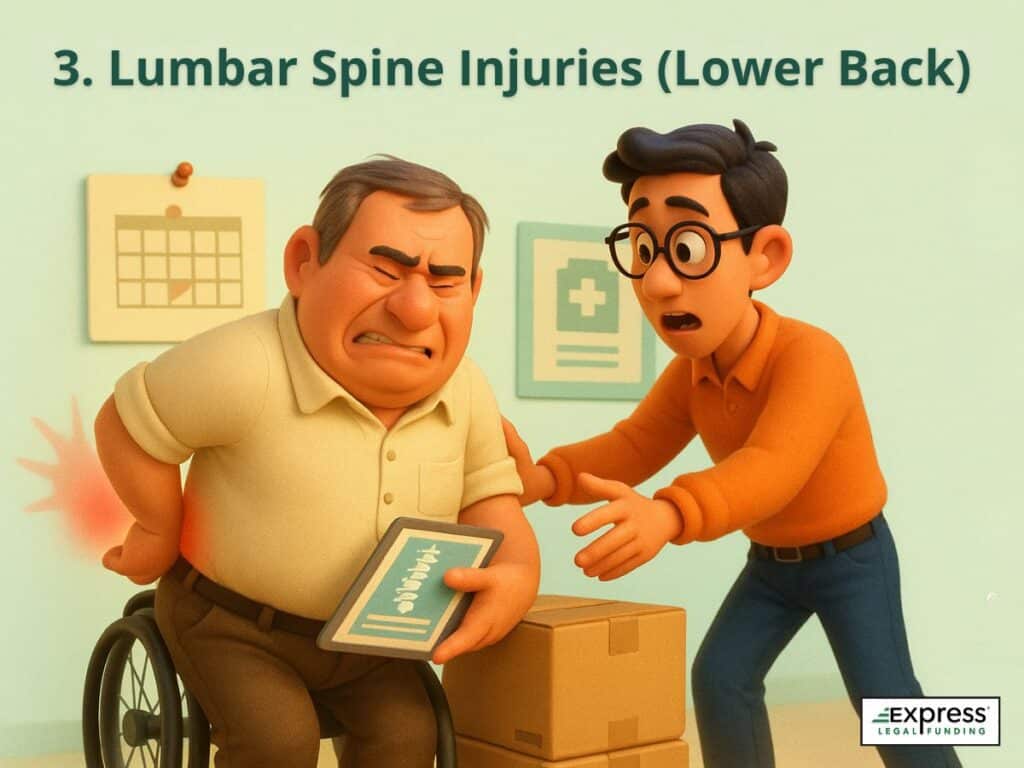
Lumbar spine injuries involve the lower back region, affecting the five vertebrae labeled L1 through L5. This section of the spine bears the majority of the body’s weight and is crucial for mobility, posture, and core stability. Due to its load-bearing role and frequent use in physical activity, the lumbar spine is especially vulnerable to injury.
- Common Causes: Heavy lifting, falls, car accidents, workplace incidents, or repetitive stress.
- Symptoms: Can include severe lower back pain, reduced range of motion, leg numbness, muscle weakness, or sciatica caused by nerve impingement. Some cases involve herniated or bulging discs, spinal fractures, or chronic inflammation.
Impact on the Patient’s Life
Lumbar spine injuries can lead to long-term or permanent physical limitations, often making it difficult for individuals to sit, stand, walk, or lift objects. This can severely disrupt:
- Work performance, especially in labor-intensive jobs
- Routine daily tasks, such as dressing, driving, or housework
- Recreational activities and sleep quality
Many patients require ongoing medical care, including:
- Physical therapy
- Pain management or steroid injections
- Surgical interventions, such as spinal fusion or discectomy
- Assistive devices or home modifications
Chronic pain and functional impairment may also contribute to emotional distress, anxiety, or depression, further diminishing overall quality of life.
How It Affects the Claim or Lawsuit
Lumbar spine injuries are among the most frequently litigated spinal conditions in personal injury and workers’ compensation cases. The economic impact, including lost wages, medical bills, and future care, can be substantial, especially if the injury leads to partial disability or long-term job loss.
From a legal standpoint:
- Documentation Is Key: Comprehensive medical records showing diagnostic imaging (MRI, CT scans), physician assessments, and treatment plans help establish both the injury and its long-term effects. Documentation of pain levels, activity restrictions, and surgical recommendations strengthens claim value.
- Functional Impact Argument: These injuries commonly reduce the ability to work or require job retraining. Demonstrating lost earning potential and diminished work capacity is critical in calculating damages.
- Pain and Suffering Damages: Chronic lumbar pain, even without visible structural damage, can justify significant non-economic compensation, especially when supported by specialist testimony.
Legal Doctrines at Play
- Pre-Existing Condition Rule: If a pre-existing lumbar issue (e.g., degenerative disc disease) was exacerbated by the defendant’s actions, the at-fault party can still be held liable for the aggravated harm.
- Residual Injury Doctrine: When pain or limited mobility persists despite treatment, plaintiffs may recover damages for the permanent effects that impair their quality of life and daily function.
- Loss of Earning Capacity: When a patient cannot return to their previous occupation, especially in physical roles, courts often award future wage loss compensation.
4. Sacral Spine Injuries (Pelvic Area)
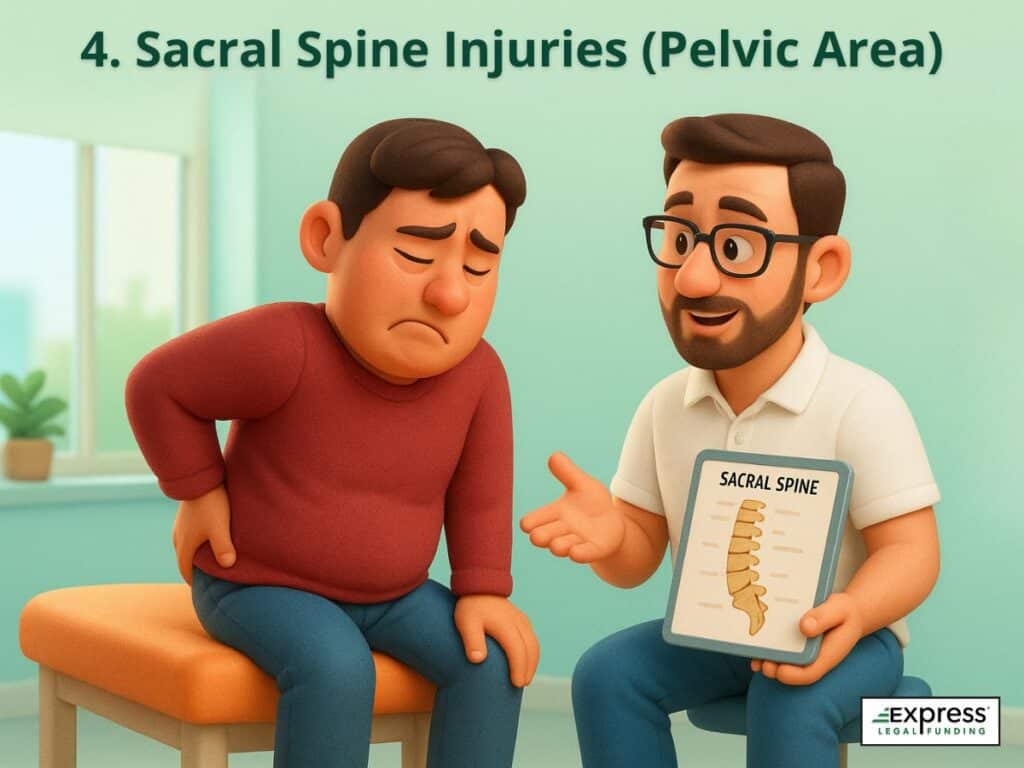
Sacral spine injuries occur in the lower back and pelvic region, affecting the sacrum, a triangular bone composed of five fused vertebrae (S1–S5) located between the lumbar spine and the tailbone (coccyx). The sacrum plays a vital role in transmitting body weight to the pelvis and legs, and supports movement, posture, and balance.
- Common Causes: Slip and fall accidents, direct trauma to the lower back or buttocks, childbirth complications, and auto or motorcycle collisions.
- Symptoms: Localized pain, bruising, nerve compression, and difficulty sitting, standing, or walking for prolonged periods. Some individuals may develop chronic pelvic instability or sacroiliac (SI) joint dysfunction.
Impact on the Patient’s Life
Though less likely to result in paralysis than injuries to the cervical or thoracic spine, sacral injuries can still cause long-term discomfort and functional impairment. Many individuals experience:
- Persistent lower back or pelvic pain
- Difficulty sitting for extended periods
- Interference with driving, working, or engaging in normal daily routines
- Emotional distress due to limited mobility and prolonged recovery
In severe cases, sacral nerve involvement may affect bladder, bowel, or sexual function, further impacting the individual’s quality of life and emotional well-being.
How It Affects the Claim or Lawsuit
Sacral spine injuries may not always involve catastrophic damage, but they still warrant compensation when caused by negligence. These injuries often require ongoing physical therapy, pain management, ergonomic modifications, or workplace accommodations, all of which contribute to the economic and non-economic damages in a personal injury claim.
From a legal standpoint:
- Moderate Settlement Value: Since sacral injuries often involve chronic pain without visible structural damage, their settlement value tends to be moderate compared to higher spinal injuries.
- Subjective Pain Claims: Insurance companies often challenge the validity and severity of pain-related symptoms, especially when imaging (X-rays, MRIs) fails to show a significant abnormality. These insurance company delay tactics are used to minimize payouts and dispute medical necessity.
- Need for Expert Testimony: Medical documentation from orthopedic specialists, pain management doctors, or physical therapists is crucial to support the injury’s seriousness and long-term impact.
Legal Doctrines at Play
- Pre-Existing Condition Defense: Defendants may argue that pain or functional limitations stem from prior injuries, degenerative changes, or age-related wear, rather than the incident in question.
- Loss of Enjoyment of Life: Plaintiffs may be entitled to compensation for lifestyle disruptions, such as the inability to sit comfortably, commute, work full-time, or engage in recreational activities.
- Eggshell Plaintiff Rule: If the plaintiff had a prior vulnerability (e.g., previous pelvic trauma), the defendant is still liable for the full extent of harm caused by the new injury.
5. Coccyx Injuries (Tailbone)

Coccyx injuries, also known as coccygeal injuries, affect the tailbone—a small, triangular structure located at the very base of the spine. The coccyx typically consists of three to five fused vertebrae and serves as a crucial anchor point for ligaments, tendons, and muscles in the pelvic region.
Although small and often overlooked, injuries to this area can cause persistent pain and discomfort, especially when sitting, standing, or shifting positions.
- Common Causes: Backward falls, prolonged sitting on hard surfaces, direct trauma (e.g., slipping down stairs), childbirth complications, or repetitive strain.
- Symptoms: Localized tailbone pain (coccydynia), bruising, inflammation, swelling, and pain during sitting, standing, or bowel movements. Chronic cases may lead to persistent nerve pain or functional limitations.
Impact on the Patient’s Life
Although coccyx injuries are generally less severe than injuries to other spinal regions, they can still negatively affect daily functioning and comfort. Patients often experience:
- Sharp or aching pain when sitting or rising
- Difficulty driving or performing sedentary work
- Sleep disturbances due to discomfort in lying positions
- Anxiety, frustration, or reduced participation in social activities
Prolonged cases may require pain management, cushion support, physical therapy, or, in rare cases, surgical removal of the coccyx (coccygectomy).
How It Affects the Claim or Lawsuit
Coccyx injuries are often classified as minor to moderate soft tissue or skeletal injuries, but their persistent pain and functional impact can still justify legal compensation, especially when caused by clear negligence, such as unsafe flooring or poor workplace ergonomics.
From a legal standpoint:
- Lower to Moderate Settlement Value: These injuries typically result in limited medical costs but can still merit compensation for pain and suffering, especially if symptoms are prolonged or interfere with work.
- Challenges with Proof: Since coccyx injuries are often not clearly visible on standard imaging, claims may face increased scrutiny or denials from insurers who question the severity.
- Importance of Medical Support: Diagnosis from a pain management specialist or orthopedist and consistent documentation of symptoms are essential to validate the claim.
Legal Doctrines at Play
- Pre-Existing Condition Defense: Defendants may argue that tailbone pain results from prior injuries, aging, or degenerative joint disease rather than the incident at issue.
- Residual Injury Doctrine: If pain persists beyond the expected healing period, plaintiffs may claim residual damages for chronic discomfort and lifestyle disruptions.
- Loss of Enjoyment of Life: Even without paralysis or structural instability, plaintiffs may seek damages for reduced comfort during daily activities, such as sitting, commuting, or working at a desk.
Spinal Cord Injury Classifications: Complete vs. Incomplete
In both medical and legal contexts, distinguishing between complete and incomplete spinal cord injuries is critical. This classification directly impacts the injured person’s prognosis, long-term treatment plan, and the value of a personal injury claim or lawsuit.
Complete Spinal Injury
A complete spinal injury involves a total loss of motor and sensory function below the level of the injury. This means the spinal cord has been fully severed, crushed, or rendered nonfunctional, preventing any nerve signals from traveling past the damaged area.
Common Outcomes:
- Paraplegia (loss of function in the lower body)
- Quadriplegia (loss of function in all four limbs), depending on the injury level
These injuries are often permanent, resulting in profound and lifelong impairments to movement, independence, and bodily control.
Incomplete Spinal Injury
An incomplete spinal injury occurs when the spinal cord is partially damaged, allowing for some preservation of function below the injury site. The degree of retained mobility or sensation can vary widely:
- Some patients may be able to walk with assistance
- Others may retain partial limb movement, sensation, or autonomic functions (e.g., bowel or bladder control)
While incomplete injuries may offer better recovery prospects, they also bring uncertainty in diagnosis and legal valuation due to their variability.
Why the Incomplete vs. Complete Spinal Injury Distinction Matters
Medically
- Helps determine the likelihood of neurological recovery
- Guides decisions on rehabilitation, mobility aids, and surgical interventions
- Influences the scope of physical therapy and long-term care planning
Legally
The classification of a spinal injury—complete vs. incomplete—has a major influence on the potential value of a legal claim, as it affects both economic and non-economic damages.
How It Affects the Claim or Lawsuit
Higher Compensation for Complete Spinal Injuries
Complete spinal injuries usually result in higher-value settlements or verdicts due to the injury’s severe and permanent nature. Key factors driving compensation include:
- Total loss of motor function and independence
- Inability to return to employment or earn a living wage
- Need for lifelong medical care, home assistance, and equipment
- Psychological trauma and diminished enjoyment of life
Because these injuries are medically well-documented and irreversible, they are less likely to be disputed and easier to present in court with objective evidence.
Variable Outcomes for Incomplete Spinal Injuries
Incomplete spinal injuries present greater legal complexity:
- Symptoms may improve or worsen over time
- Functional loss can be partial, intermittent, or hard to measure
- Defendants and insurers often challenge the extent of impairment
Plaintiffs must provide strong medical evidence and expert opinions to demonstrate the true impact of their injuries and justify compensation.
Common Legal Classifications for Spinal Injuries
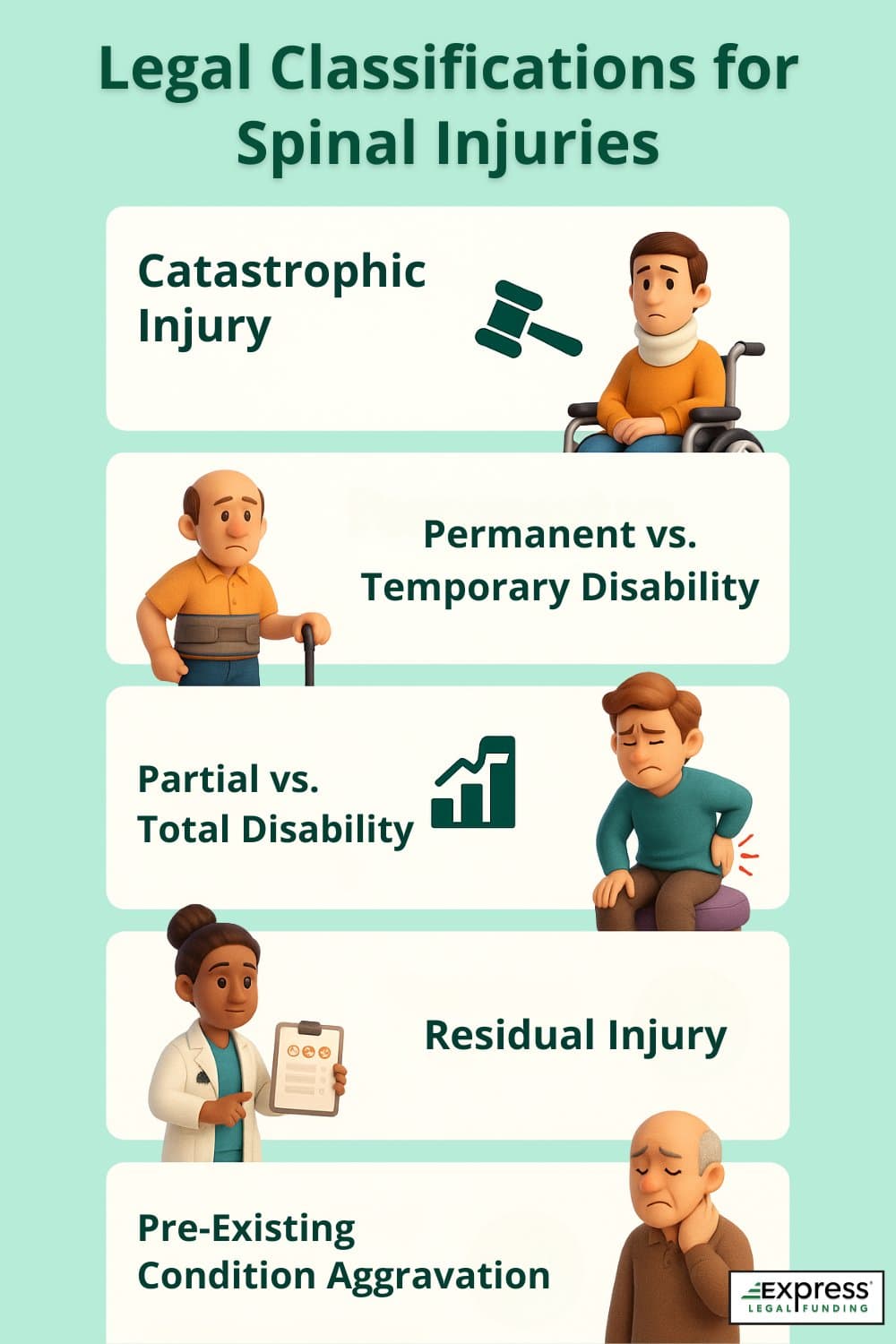
Legal classifications help determine the scope of compensation in spinal injury claims by assessing how an injury affects a person’s ability to function, work, and recover. Below are key legal categories often applied in personal injury and workers’ compensation cases:
Catastrophic Injury
- Definition: A spinal injury is deemed catastrophic when it causes permanent disability, such as paralysis or severe nerve damage, preventing the person from returning to gainful employment.
- Legal Impact:
- Qualifies for enhanced damages, including lifetime care costs, pain and suffering, and future wage loss
- May override damage caps in some states
- Common in third-party liability and workers’ compensation cases
Permanent vs. Temporary Injury
- Definition:
- Permanent: Long-term or irreversible impairment (e.g., partial paralysis)
- Temporary: Expected to resolve over time (e.g., disc sprain, soft tissue strain)
- Legal Impact:
- Permanent injuries result in higher compensation due to ongoing care needs and lost earning potential
- Courts often rely on permanent disability ratings to determine payout amounts
Partial vs. Total Disability
- Definition:
- Total: The injured person cannot perform any substantial work
- Partial: The person has limited ability to work or must change professions
- Legal Impact:
- Influences wage replacement, disability benefits, and vocational retraining
- Often supported by a Functional Capacity Evaluation (FCE) or expert opinion
Residual Injury
- Definition: The injury causes lingering symptoms despite treatment (e.g., chronic pain, limited mobility)
- Legal Impact: Justifies claims for future medical care, ongoing pain, and loss of enjoyment of life
Pre-Existing Condition Aggravation
- Definition: A new incident worsens a prior spinal condition, such as an old herniated disc
- Legal Impact: Courts apply the eggshell skull doctrine—the defendant is liable for the full extent of the worsened condition, even if the plaintiff was more vulnerable
Why the Type of Spinal Injury Impacts Lawsuit & Settlement Value
The type, location, and severity of a spinal injury play a central role in determining the value of a personal injury lawsuit or settlement. Each region of the spine—cervical, thoracic, lumbar, sacral, and coccyx—carries unique medical implications that directly affect recovery time, functional limitations, and legal classification.
- Cervical spine injuries often result in severe neurological damage and loss of mobility, leading to higher compensation due to permanent disability, extensive care needs, and diminished earning capacity.
- Thoracic and lumbar injuries may cause chronic pain, nerve damage, or limited mobility, affecting a person’s ability to work, drive, or perform daily tasks, especially in physically demanding jobs.
- Sacral and coccygeal injuries, though typically less severe in terms of paralysis, can still lead to long-term discomfort, lifestyle limitations, and reduced quality of life, which justify compensation for pain and suffering.
Because spinal injuries vary widely in functional impact, treatment requirements, and potential for recovery, courts and insurers evaluate each case individually. These assessments include:
- Direct medical costs (e.g., surgery, therapy, medications)
- Lost income and reduced future earning potential
- Non-economic damages, such as emotional distress, loss of independence, and diminished enjoyment of life
Ultimately, the legal value of a spinal injury claim hinges on a thorough understanding of the anatomical region affected, the severity of impairment, and how these factors translate into real-world limitations. This underscores the importance of detailed medical records, expert evaluations, and accurate legal classification when seeking fair and just compensation.
Don’t wait to take legal action. Learn your deadlines in our guide: Statute of Limitations for Spinal Injury Lawsuits
FAQs: Types of Spinal Injuries and Their Legal Impact

Why does the type of spinal injury affect a lawsuit settlement?
The type of spinal injury determines how severely a person is impacted physically and financially. Injuries higher on the spine, like cervical injuries, often result in paralysis and require lifelong care, leading to larger settlements. Less severe injuries, such as coccyx trauma, may still justify compensation but typically result in lower claim values.
What are the most severe types of spinal injuries?
Cervical spinal cord injuries are generally the most severe because they can result in quadriplegia and loss of respiratory function. These injuries typically qualify as catastrophic under legal classifications and are associated with the highest settlement values due to permanent disability and extensive care needs.
Can a coccyx injury still result in compensation?
Yes. While coccyx injuries do not typically cause paralysis, they can lead to chronic pain, difficulty sitting or standing, and loss of mobility. Plaintiffs may receive compensation for pain and suffering, lost wages, and reduced quality of life.
How do complete and incomplete spinal injuries differ in legal cases?
Complete injuries involve total loss of function below the injury site and often lead to higher compensation due to permanent impairment. Incomplete injuries have variable outcomes, which can complicate legal valuation. Proving long-term impact in these cases requires strong medical evidence and expert testimony.
What legal doctrines apply to spinal injury claims?
Common doctrines applicable to spinal cord injuries include:
- Comparative fault: Reduces compensation if the plaintiff is partly at fault.
- Catastrophic injury classification: Unlocks broader damage categories.
- Residual injury doctrine: Supports claims for ongoing pain after treatment.
- Pre-existing condition rule: Holds defendants liable for aggravating prior injuries.
Do different spinal injury locations affect compensation differently?
Yes, different spinal injury locations can lead to different settlement amounts based on the severity and impact of the injury:
- Cervical spine injuries are the most serious and often lead to paralysis, resulting in the highest compensation.
- Thoracic and lumbar injuries commonly affect mobility and work ability, leading to moderate to high settlements.
- Sacral and coccyx injuries usually cause pain while sitting or standing and tend to result in lower compensation because they’re harder to document with objective medical imaging like X-rays or MRIs.
Conclusion: The Legal Weight of Spinal Injury Type
Spinal injuries are among the most complex and life-altering forms of trauma, and no two cases are alike. Whether involving the cervical, thoracic, lumbar, sacral, or coccygeal regions, each type of spinal injury carries its own set of medical challenges and legal implications. From temporary limitations to permanent paralysis, the nature of the injury will strongly influence the value of any lawsuit settlement.
Understanding the type, location, and severity of a spinal injury is essential for determining fair compensation. Legal professionals, insurers, and courts must weigh not only the immediate medical costs but also the long-term consequences, including lost income, permanent disability, and diminished quality of life.
If you or a loved one has suffered a spinal injury due to someone else’s negligence, it’s crucial to work with experienced legal counsel and medical professionals who can accurately assess the damages and protect your right to full and fair compensation. A detailed legal evaluation—combined with proper medical documentation—can make the difference in securing the financial support needed to rebuild your life.
Get Pre-Settlement Funding on Your Spinal Injury Lawsuit with Express Legal Funding

Suffering a spinal injury can be physically, emotionally, and financially overwhelming, especially when your case is still pending in court. At Express Legal Funding, we understand how costly these injuries can be. From hospital bills and physical therapy to lost income and mobility aids, the expenses add up quickly.
That’s where we can help.
Express Legal Funding offers pre-settlement funding—a risk-free cash advance provided to plaintiffs involved in personal injury lawsuits, including those suffering from serious spinal injuries. This type of funding is not a loan, which means you only repay the advance if you win or settle your case. If you lose, you owe us nothing.
We provide fast and affordable spinal injury lawsuit loans to help you:
- Pay for essential living expenses while you recover
- Cover medical costs, such as surgery, rehabilitation, or mobility equipment
- Avoid pressure to accept a lowball settlement offer
Whether your injury involves the cervical, thoracic, lumbar, or sacral spine, we offer funding tailored to the severity and strength of your case.
Depending on the type and severity of the spinal injury and insurance coverage, plaintiffs may be eligible for varying levels of legal funding. Learn how much pre-settlement funding you can qualify for.
Our team works directly with your attorney to review your claim quickly and get you cash, often in less than 24 hours of approval.
At Express Legal Funding, we’ve helped hundreds of plaintiffs with spinal injuries secure the pre-settlement cash they need while pursuing fair compensation.
Aaron Winston, PhD
Apply for Pre-Settlement Funding Today
Don’t let financial stress worsen an already difficult situation. Contact Express Legal Funding today to find out how much cash you could receive while waiting for your spinal injury case to settle.
➡️ Apply Now for Legal Funding or call us at (888) 232-9223 to get started.
Glossary of Key Terms in This Article
- Cervical Spine: The upper portion of the spinal column, comprising vertebrae C1 through C7, located in the neck.
- Thoracic Spine: The mid-to-upper back section of the spine, made up of vertebrae T1 to T12, which connect to the rib cage.
- Lumbar Spine: The lower back segment of the spine, consisting of vertebrae L1 through L5, which support most of the body’s weight.
- Sacral Spine: Located in the pelvis and lower back, it includes the sacrum, five fused vertebrae (S1–S5), positioned between the lumbar spine and coccyx.
- Coccyx: Commonly known as the tailbone, this is a small, triangular structure at the base of the spine, usually formed by three to five fused vertebrae.
- Spinal Cord Injury (SCI): Damage to the spinal cord or nerves at the base of the spinal canal, interrupting communication between the brain and body.
- Complete Spinal Injury: A total loss of motor and sensory function below the injury site, with no nerve signals passing the damaged area.
- Incomplete Spinal Injury: Partial damage to the spinal cord, resulting in some retained movement or sensation below the level of injury.
- Quadriplegia: Paralysis affecting all four limbs and the torso, typically caused by damage to the cervical spine.
- Paraplegia: Impairment or loss of function in the lower half of the body, often due to thoracic spinal cord injuries.
- Catastrophic Injury: A legal classification for severe spinal injuries that result in permanent disability and prevent gainful employment.
- Permanent Injury: A long-lasting or irreversible impairment due to a spinal injury.
- Temporary Injury: A spinal injury that is expected to heal or improve over time with appropriate medical treatment.
- Partial Disability: A condition where the injured person has limited ability to work or must change careers due to spinal injury.
- Total Disability: A state in which an individual is unable to perform any substantial gainful activity because of a spinal injury.
- Residual Injury: Ongoing symptoms such as chronic pain or reduced mobility that persist even after treatment.
- Pre-Existing Condition Aggravation: When a new injury exacerbates an existing spinal condition.
- Comparative Fault: A legal concept that reduces compensation if the injured party shares some responsibility for the incident.
- Eggshell Plaintiff Rule (Eggshell Skull Doctrine): A legal principle stating that defendants are fully liable for injuries, even if the plaintiff had a pre-existing vulnerability that worsened the outcome.
- Loss of Earning Capacity: Financial damages awarded when a spinal injury limits a person’s ability to earn income at their previous level.
- Pain and Suffering: Non-economic compensation for physical pain, emotional distress, and reduced quality of life due to injury.
- Pre-Settlement Funding: A non-recourse cash advance given to plaintiffs in ongoing personal injury cases, repaid only if the case is won.
- Economic Damages: Measurable financial losses such as hospital bills, physical therapy, and lost income resulting from a spinal injury.
- Non-Economic Damages: Compensation for intangible losses like emotional anguish, loss of companionship, and reduced independence following a spinal injury.
Citations:
- Cleveland Clinic. (n.d.). Spinal cord injury. Cleveland Clinic. https://my.clevelandclinic.org/health/diseases/12098-spinal-cord-injury
- National Institute of Neurological Disorders and Stroke. (n.d.). Spinal cord injury. National Institutes of Health. https://www.ninds.nih.gov/health-information/disorders/spinal-cord-injury

